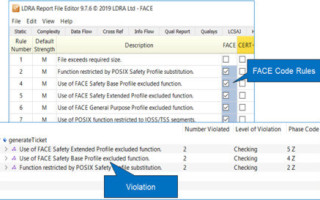Vendor backing grows for the emerging FACE standard
BlogApril 30, 2019

Avionics vendors ? hardware and software ? share an enthusiasm for the Future Airborne Capability Environment (FACE) Technical Standard, which promotes a common operating environment with reuse of software capabilities across multiple Department of Defense (DoD) avionics systems. This enthusiasm continues to grow as does participation within the FACE consortium ? run by the Open Group ? as the version 3.0 of the standard is soon to be released. The long -term life-cycle cost savings enabled by reuse standards such as FACE are changing the face of the DoD the procurement process for embedded computing solutions.
The Open Group provides a vendor-neutral forum for industry and government to work together to achieve business objectives through technology standards. The organization is also behind another hot DoD reuse initiative, the Sensor Open Systems Architecture (SOSA).
The FACE Technical Standard is an important milestone in extending interoperability among the armed forces and enabling systems to work together across each of the branches of the U.S. military. Numerous software-certified units of conformance (UoC) have emerged and the reduction of costs and complexity that they provide are too attractive to ignore. However, implementation of the FACE standard by software suppliers comes with a learning curve.
To simplify acceptance, the FACE Technical Standard offers a Conformance Verification Matrix (CVM) spreadsheet, which is an abbreviation and simplification of the FACE Technical Standard. The CVM contains the requirements for all the segments of the open architecture and the spreadsheet includes a Software Supplier Artifact Cross Reference column with corresponding requirement rows used to collect the artifact(s) needed to show fulfillment of the requirement.
A FACE Conformance Test Suite (CTS) is also provided to test the software and verify its adherence to the FACE Technical Standard before submitting to the Verification Authority (VA). Test summary results are captured and documented and a pass/fail verdict is rendered by the CTS. The results include a summary of each test case result, test configuration settings, version of the CTS used, date and time of the test run, edition of the FACE Technical Standard applied, and more.
Government stakeholders can then search the FACE Library for FACE-certified products to procure, including these examples. Harris offers its FliteScene Digital Map, a high-performance, combat-proven and feature-rich digital moving map with situational awareness and obstacle avoidance. Collins Aerospace offers its Mission Flight Management Software (MFMS-1000), an advanced flight-management capability that enables seamless, global interoperability between civil and mission airspace to reduce pilot workload and training. Wind River offers the first single-core and multi-core certified conformant FACE Operating System Segment (OSS) Safety Base Profile product for the P4080, P2020 and P3041. QorIQ Power architecture processors with full ARINC 653 and POSIX support are also supported. These and other offerings found in the FACE Library help prove that system-of-systems integration is not only possible but can be achieved in a rapid manner with safety and security built in, verifying objectives in affordability, speed, agility, and excellence.
Tool vendors are also offering solutions to help build FACE-conformant products. By integrating the FACE CVM into their products, tool vendors can help remove the uncertainty and ambiguity of having to interpret the CVM spreadsheet, providing a leap forward for developers. A collaborative project environment and feature-rich infrastructure should target selected FACE Reference Architecture segment under development, such as OSS, PCS, TSS, PSSS, and IOSS. Tools such as those from LDRA provide assistance in ensuring FACE conformance through automation, FACE coding standards compliance, traceability, artifact generation and FACE CTS execution against code, as well as DO-178B/C certification up to and including design assurance Level A.
Tools should invoke current verification test suites in order to build source code against the CTS before submitting it to the Verification Authority (VA). In many ways, this becomes the first unofficial test of the source code against the official conformance utility. Any non-conformances in the source code will be exposed, giving the user the ability to correct any issues before officially submitting it to the VA.
As the FACE standard continues to grow in use and with its committee goals to expand into non-avionics and non-military markets, expect to see additional vendor solutions and competing solutions which aid in the adoption and time to market needs of software suppliers building FACE UoCs.




